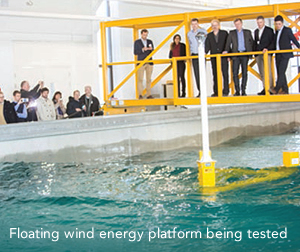 The FP7 LEANWIND project addresses key targets of both the European Wind and Transport Technology Platforms, with a focus on reducing the cost of offshore wind. The project aims to contribute to cost reduction by seeking effi ciencies across the wind farm life-cycle. LEANWIND was awarded to a consortium of 31 partners (52% from industry) from 11 countries and is led by University College Cork, Ireland. The diverse team brings together experts from multiple sectors including oil and gas, maritime, shipping and offshore wind industries with representatives across the supply chain including developers, utilities, turbine suppliers, vessel owners, shipbuilding, classifi cation societies and academics. LEANWIND is a 4 year project which commenced in December 2013 and received funding of about €10million from the European Commission.
The FP7 LEANWIND project addresses key targets of both the European Wind and Transport Technology Platforms, with a focus on reducing the cost of offshore wind. The project aims to contribute to cost reduction by seeking effi ciencies across the wind farm life-cycle. LEANWIND was awarded to a consortium of 31 partners (52% from industry) from 11 countries and is led by University College Cork, Ireland. The diverse team brings together experts from multiple sectors including oil and gas, maritime, shipping and offshore wind industries with representatives across the supply chain including developers, utilities, turbine suppliers, vessel owners, shipbuilding, classifi cation societies and academics. LEANWIND is a 4 year project which commenced in December 2013 and received funding of about €10million from the European Commission.
Core technical work examines practical ways of improving and developing technologies and strategies to optimise the deployment, maintenance and decommissioning of large-scale wind turbines. LEANWIND considers 5-8MW wind turbines using both fi xed and fl oating substructures to include long-term wind farm prospects. The transport, logistical and maintenance challenges associated with these structures are addressed by developing novel approaches to vessel design, vessel management, sub-structure alterations and O&M strategies and streamlining logistics across each project stage in order to reduce both capital (CAPEX) and operational (OPEX) costs.
Key LEANWIND innovations include:
- Novel adaptations for fixed and floating substructures to improve installation effi ciency and reduce costs. These designs incorporate innovative deployment and assembly strategies.
- Development of installation vessel design for transport and installation of 8 no.8MW turbines
- Service Operations Vessel Design to optimise O&M for far offshore sites
- Development of simulator based tools supporting concept design feasibility studies; the development of operational procedures and training of crews and operators
- A remote presence prototype to monitor turbine condition to reduce the need for offshore maintenance work
- For optimisation of O&M activities development of the following; O&M strategy optimisation models, a dynamic scheduling tool, failure/degradation models and an online system for condition monitoring and diagnosis/prognosis of faults in offshore wind turbines
- Nine inter-connected optimisation models for all life cycle phases and supply chain legs resulting in a holistic set of decision support tools applicable to port logistics, offshore and on-land transportation for the offshore wind industry
- Various testing and validation exercises including the remote presence prototype, the highwind blade installation system and the PLOCAN platform
- Holistic financial model considering business models and risk; CAPEX and installation; OPEX; decommissioning; and life-cycle assessment. These models are used in combination with the logistics models to evaluate project innovations and provide recommendations to define a roadmap for the offshore wind industry
Therefore LEANWIND is committed to developing innovative techniques and technologies tailored to match current and medium term industry needs. These will contribute to cost reduction and EU competitiveness in specific niche markets related to offshore wind.
The work described in this publication has received funding from the European Union Seventh Framework Programme under the agreement SCP2-GA-2013-614020
Contact details:
See our website www.leanwind.eu or follow us on twitter @LEANWINDFP7 for news and events.